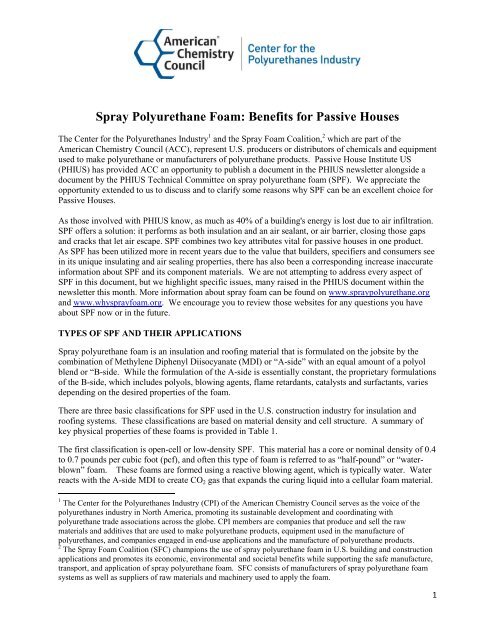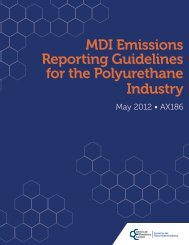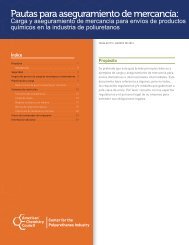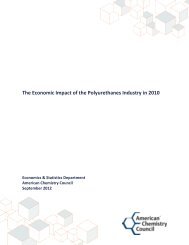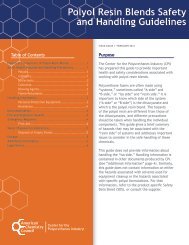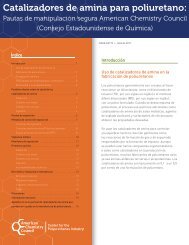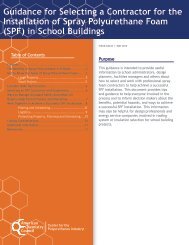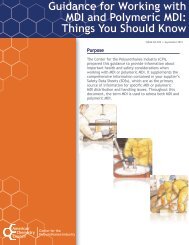Spray Polyurethane Foam: Benefits for Passive Houses
Spray Polyurethane Foam: Benefits for Passive Houses
Spray Polyurethane Foam: Benefits for Passive Houses
Create successful ePaper yourself
Turn your PDF publications into a flip-book with our unique Google optimized e-Paper software.
<strong>Spray</strong> <strong>Polyurethane</strong> <strong>Foam</strong>: <strong>Benefits</strong> <strong>for</strong> <strong>Passive</strong> <strong>Houses</strong><br />
The Center <strong>for</strong> the <strong>Polyurethane</strong>s Industry 1 and the <strong>Spray</strong> <strong>Foam</strong> Coalition, 2 which are part of the<br />
American Chemistry Council (ACC), represent U.S. producers or distributors of chemicals and equipment<br />
used to make polyurethane or manufacturers of polyurethane products. <strong>Passive</strong> House Institute US<br />
(PHIUS) has provided ACC an opportunity to publish a document in the PHIUS newsletter alongside a<br />
document by the PHIUS Technical Committee on spray polyurethane foam (SPF). We appreciate the<br />
opportunity extended to us to discuss and to clarify some reasons why SPF can be an excellent choice <strong>for</strong><br />
<strong>Passive</strong> <strong>Houses</strong>.<br />
As those involved with PHIUS know, as much as 40% of a building's energy is lost due to air infiltration.<br />
SPF offers a solution: it per<strong>for</strong>ms as both insulation and an air sealant, or air barrier, closing those gaps<br />
and cracks that let air escape. SPF combines two key attributes vital <strong>for</strong> passive houses in one product.<br />
As SPF has been utilized more in recent years due to the value that builders, specifiers and consumers see<br />
in its unique insulating and air sealing properties, there has also been a corresponding increase inaccurate<br />
in<strong>for</strong>mation about SPF and its component materials. We are not attempting to address every aspect of<br />
SPF in this document, but we highlight specific issues, many raised in the PHIUS document within the<br />
newsletter this month. More in<strong>for</strong>mation about spray foam can be found on www.spraypolyurethane.org<br />
and www.whysprayfoam.org. We encourage you to review those websites <strong>for</strong> any questions you have<br />
about SPF now or in the future.<br />
TYPES OF SPF AND THEIR APPLICATIONS<br />
<strong>Spray</strong> polyurethane foam is an insulation and roofing material that is <strong>for</strong>mulated on the jobsite by the<br />
combination of Methylene Diphenyl Diisocyanate (MDI) or “A-side” with an equal amount of a polyol<br />
blend or “B-side. While the <strong>for</strong>mulation of the A-side is essentially constant, the proprietary <strong>for</strong>mulations<br />
of the B-side, which includes polyols, blowing agents, flame retardants, catalysts and surfactants, varies<br />
depending on the desired properties of the foam.<br />
There are three basic classifications <strong>for</strong> SPF used in the U.S. construction industry <strong>for</strong> insulation and<br />
roofing systems. These classifications are based on material density and cell structure. A summary of<br />
key physical properties of these foams is provided in Table 1.<br />
The first classification is open-cell or low-density SPF. This material has a core or nominal density of 0.4<br />
to 0.7 pounds per cubic foot (pcf), and often this type of foam is referred to as “half-pound” or “waterblown”<br />
foam. These foams are <strong>for</strong>med using a reactive blowing agent, which is typically water. Water<br />
reacts with the A-side MDI to create CO2 gas that expands the curing liquid into a cellular foam material.<br />
1 The Center <strong>for</strong> the <strong>Polyurethane</strong>s Industry (CPI) of the American Chemistry Council serves as the voice of the<br />
polyurethanes industry in North America, promoting its sustainable development and coordinating with<br />
polyurethane trade associations across the globe. CPI members are companies that produce and sell the raw<br />
materials and additives that are used to make polyurethane products, equipment used in the manufacture of<br />
polyurethanes, and companies engaged in end-use applications and the manufacture of polyurethane products.<br />
2 The <strong>Spray</strong> <strong>Foam</strong> Coalition (SFC) champions the use of spray polyurethane foam in U.S. building and construction<br />
applications and promotes its economic, environmental and societal benefits while supporting the safe manufacture,<br />
transport, and application of spray polyurethane foam. SFC consists of manufacturers of spray polyurethane foam<br />
systems as well as suppliers of raw materials and machinery used to apply the foam.<br />
1


